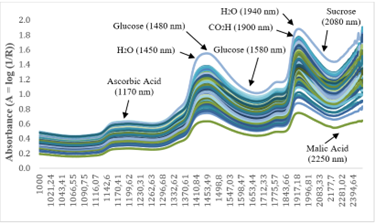Feasibility Analysis of Using NIR Spectroscopy to Predict Ripeness Parameters of Red Guava Fruit (Psidium guajava L.)
Abstract
Red guava is highly preferred by Indonesians because of its delightful flavor, refreshing taste, and numerous advantages. It is a climacteric fruit, and the age at which red guava is picked affects the quality of the fruit. The estimation of the maturity parameters of red guava is physically destructive (damages the fruit). This study aimed to assess the NIR method to predict the maturity parameters of red guava fruit with wavelengths of 1000-2500 nm. Red guavas of four different picking ages were used in this study. The tested maturity parameters included firmness, moisture content, total soluble solids (TSS), acidity, and sugar-acid ratio at various harvest ages. The partial least squares (PLS) method was used for calibration and validation of NIRS data and reference data. The results of this study show that NIRS can estimate the ripeness of red guava fruit based on firmness, acidity, sugar-acid ratio, and water content. The best-estimated value for firmness parameters was obtained with pretreatment MSC factor PLS 14, resulting in r calibration of 0.94, SEP 7.20, CV 25.91%, and RPD 2.90; acidity without pretreatment factor PLS 13 obtained r calibration of 0.82, SEP 0.17, CV 24.42%, RPD 1.68; sugar acid ratio with pretreatment SNV factor PLS 10 obtained r calibration 0.75, SEP 4.03, CV 30.81%, RPD 1.51; and for moisture content using SNV pretreatment factor PLS 13, r calibration 0.88, SEP 0.95, CV 1.08%, RPD 1.95.
Authors

This work is licensed under a Creative Commons Attribution-ShareAlike 4.0 International License.
Authors submitting manuscripts should understand and agree that copyright of manuscripts of the article shall be assigned/transferred to Jurnal Keteknikan Pertanian. This work is licensed under a Creative Commons Attribution-ShareAlike 4.0 International License (CC BY-SA) where Authors and Readers can copy and redistribute the material in any medium or format, as well as remix, transform, and build upon the material for any purpose, but they must give appropriate credit (cite to the article or content), provide a link to the license, and indicate if changes were made. If you remix, transform, or build upon the material, you must distribute your contributions under the same license as the original.

